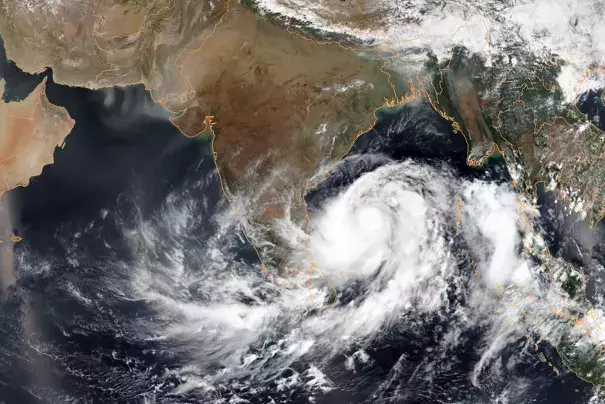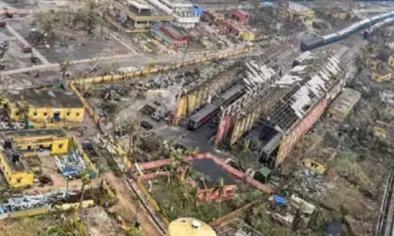Cyclone Fani 2019
Cyclone Fani was the strongest pre-monsoon cyclone in the Bay of Bengal since 1991. (Cyclone Amphan in May 2020 became even stronger.) The storm killed 81 people in eastern India and Bangladesh and caused $8.1 billion of damages. Warming seas and a wetter atmosphere due to climate change are supercharging the deluge delivered by tropical cyclones like Fani.[1]

Climate science at a glance
- A climate change attribution study looking at Cyclone Fani's intensity found that warming air and sea surface temperatures have significantly intensified cyclones in the Bay of Bengal, especially in the pre-monsoon month of May.[1]
- Global warming is increasing water vapor in the air, which in turn is fueling extreme rainfall, increasing the threat of flooding.[2]
- Global warming is also heating up sea surface temperatures, which in turn raises the maximum potential energy a storm can reach.[3]
- Tropical cyclones have shifted toward the poles and this shift is likely due to global warming.[4][5]
Background
When does cyclone season peak in the Bay of Bengal?
Cyclone season in the Bay of Bengal peaks during April-May and October-November, on either side of the monsoon season. Fani was an unusual springtime threat for eastern India, as most of the April and May cyclones in this region move east or northeast toward Bangladesh and Myanmar. In eastern India, most of the worst cyclones have struck during the fall months.[6]
Climate signal breakdown
Climate signals #1 and #2: Extreme Precipitation Increase and Flood Risk Increase
Climate change is fueling extreme rainfall and dramatically increasing rainfall across many types of storms, and an increase in rainfall rates is one of the more confident predictions of the effects of climate change on tropical cyclones.[2][3]
As the global average temperature increases, so too does the ability of the atmosphere to hold and dump more water when it rains.[2] Atmospheric water vapor has been increasing.[7][8] And the observed increases have been studied and formally attributed to global warming.[9][10][11]
Observations consistent with climate signals #1 and #2
- Fani dumped generally 4 to 8 inches of rain in parts of Odisha state. Bhubaneswar reported 200 mm - roughly 7.87 inches of rain - in 24 hours ending the morning of May 3.
- Some of the heaviest rainfall rates were up to 2 inches per hour.
Climate signal #3: Sea Surface Temperature Increase
Cyclones are fueled by available heat. Warming seas can make cyclones more powerful, by increasing the potential energy available to them, effectively increasing their power ceiling or speed limit.[3][12] Higher sea-surface temperatures mean that cyclone wind speeds can increase.[3] Globally, ocean temperatures have increased as a result of climate change - and there has been a global increase in the observed intensity of the strongest storms over recent decades.
Observations consistent with climate signals #3
- The local sea surface temperature anomaly at Fani’s position reached as high as 4.5°F (2.5°C), which is in line with projections from the post-1980 warming trend of the Bay of Bengal sea surface temperature during May.
- Fani attained 1-minute sustained winds of 155 mph, just 2mph below Category 5-equivalent tropical cyclone intensity.[6]
- Fani made landfall near Puri, Odisha as an extremely severe cyclonic storm, with 3-minute sustained winds of 115 mph.
- At the time, Fani was the sixth strongest tropical cyclone ever recorded in the Bay of Bengal.[6]
Climate signal #4: Storm Surge Increase
Global warming is driving up sea level, which greatly extends the reach of storms along low-lying areas. Increases in storm surge related to climate change can be due to rising seas, increasing size, and increasing storm wind speeds.[3][13]
Coastal communities are at risk. A small vertical increase in sea level can translate into a very large increase in horizontal reach by storm surge depending upon local topography.
In the United States from 1963 to 2012, 88 percent of storm-related fatalities occurred in water-related incidents; storm surge caused 49 percent and freshwater floods due to heavy rainfall caused 27 percent.[14] Globally, storm surge kills an average of 13,000 people each year.[15]
Observations consistent with climate signal #4
- Storm surge of around 4.9 feet (1.5 meters) was reported in coastal areas.
- Fani’s landfall to the western side of the bay meant that the storm surge just to the right of the center was less than a landfall at the top of the bay would have produced.










